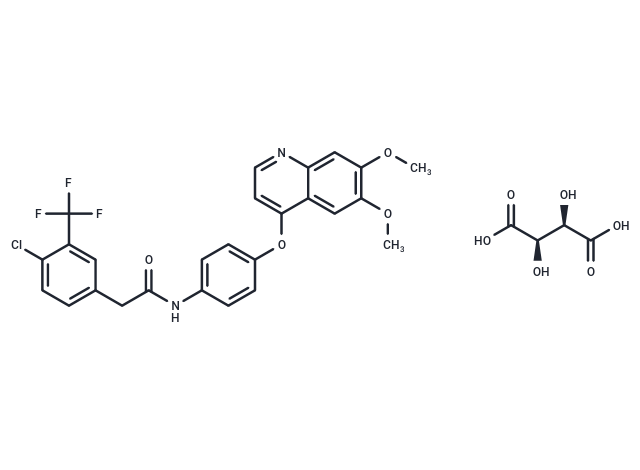Shopping Cart
- Remove All
 Your shopping cart is currently empty
Your shopping cart is currently empty

c-Kit-IN-3 L-tartrate is a potent and selective c-KIT kinase inhibitor (IC50s: 4 nM, 8 nM for c-KIT wt, and c-KIT T670I).

| Pack Size | Price | Availability | Quantity |
|---|---|---|---|
| 25 mg | $1,520 | 4-6 weeks | |
| 50 mg | $1,980 | 4-6 weeks | |
| 100 mg | $2,500 | 4-6 weeks |
| Description | c-Kit-IN-3 L-tartrate is a potent and selective c-KIT kinase inhibitor (IC50s: 4 nM, 8 nM for c-KIT wt, and c-KIT T670I). |
| Targets&IC50 | c-Kit (T670I):8 nM , c-Kit (WT):4 nM |
| In vitro | c-Kit-IN-3 L-tartrate (Compound 18; 0.1-10 μM; 6 days; primary GIST patient cells) exhibits dose-dependent antiproliferative effects. c-Kit-IN-3 (0.01-1 μM; 24 hours; GIST-T1, GIST-T1-T670I, and GIST-5R cells) treatment induces dose-dependent cell apoptotic death. c-Kit-IN-3 (0.01-1 μM; 24 hours; GIST-T1, GIST-T1-T670I, and GIST-5R cells) treatment arrests the cell cycle into the G0/G1 phase in all of these three cell lines. c-Kit-IN-3 (0-1 μM; 24 hours) blocks the autophosphorylation of c-KIT pY703, pY719, and pY823 in GIST-T1, GIST-T1-T670I, and GIST-5R, respectively, cells at a concentration of 30 nM and inhibits the downstream signaling mediators pAKT (T308/S473), pS6 (S235/236), and pERK (T202/204). c-Kit-IN-3 potently inhibits the activity of CSF1R (IC50: 18 nM), PDGFRα (IC50: 25 nM), RET (IC50: 34 nM), and it relatively less potently inhibits DDR1 (IC50: 135 nM), FLT4 (IC50: 121 nM), and PDGFRβ (IC50: 97 nM). c-Kit-IN-3 (0.006 μM-1.37 μM) potently inhibits the growth of c-KIT-dependent GIST cancer cells, such as GIST-T1 (IC50: 0.006 μM); GIST-882 (IC50: 0.013 μM); GIST-T1-T670I (IC50 : 0.011 μM); GIST-5R (IC50: 0.073 μM); GIST-48B (IC50: 1.37 μM), respectively. |
| In vivo | c-Kit-IN-3 L-tartrate (oral gavage; 20-100 mg/kg/day; for 11 days; female BALB/C-nu mice) treatment dose-dependently inhibits the tumor progression. c-Kit-IN-3 (1 mg/kg iv for mice, rats, dog; 10 mg/kg p.o. for mice, rats; and 5 mg/kg p.o. for dog) has T1/2 of 4.5 h, 6.4 h, 19.4 h for mice, rats and dogs, respectively. And it possesses acceptable bioavailability in mice (F = 43%), rats (F = 50%), and dogs (F = 81%). |
| Molecular Weight | 666.98 |
| Formula | C30H26ClF3N2O10 |
| Relative Density. | no data available |
| Storage | Powder: -20°C for 3 years | In solvent: -80°C for 1 year | Shipping with blue ice. |

Copyright © 2015-2025 TargetMol Chemicals Inc. All Rights Reserved.